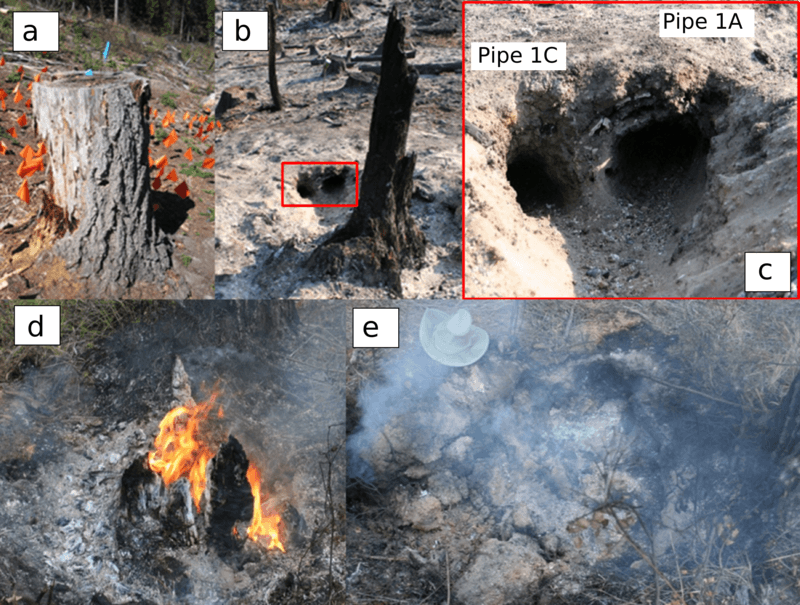
The Fire May Be Out Above Ground But Not Below
Did you know that after a forest fire tree roots can continue to burn? Usually dirt is used to snuff out a fire. So how is it possible for tree roots to burn after the above-ground fire is out?
“There is enough oxygen,” says University of Idaho Professor of Forest Resources Alistair Smith. “They don’t need much continuous air to sustain smoldering combustion. It helps that the burned out roots essentially form chimneys that enable some degree of air circulation.”
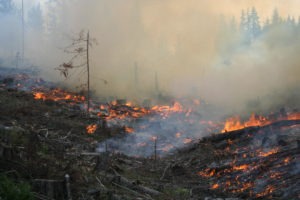
The practice of timber harvest tends to leave behind a large number of even-aged stumps and roots which will combust at similar rates. So it is likely that timber harvests enhance the occurrence of such soil pipes in forested watersheds. CREDIT ROBERT HEINSE / UNIVERSITY OF IDAHO
Imagine a stump and its root system burning to ash. What are left behind are tunnels. You could step on and fall through these hot spots, according to a warning on the North Star Fire Colville Indian Reservation Facebook page. But Smith says he hasn’t heard of many hikers having this experience and adds that a real problem is the ability of water to flow down the slopes.
This led us to University of Idaho Professor Robert Heinse who studies these systems. “Root materials that have been decaying in forest soils for some decades can combust during forest fires and either create what we call soil pipes – large open networks in the soil – or at least connect such networks to the soil surface.”
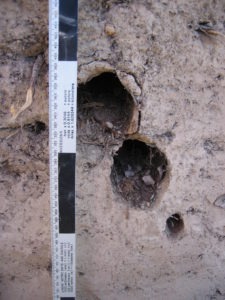
Large scale fires create more soil pipes than burrowing animals which allows for more water to flow downhill and that can cause loss of water retention in forests.
CREDIT ROBERT HEINSE / UNIVERSITY OF IDAHO
Burrowing animals also make tunnels but in the case of large forest fires, soil pipes are created en masse and stay for a long time. When there is heavy rainfall or rapid snow melt, the soil pipes enable water to flow downhill faster than water saturating bulk soil. This contributes to flooding and soil erosion.
Conversely, says Heinse, ”In regions with little precipitation in summer months this means less water available for forest growth and function, but also reduced stream-flows downstream.”
That’s one result of fire damage in forested areas but what about the grasslands and shrub lands of the Columbia Plateau? It would seem that shrubs and grasses rejuvenate quickly because they are smaller. But that’s not the case for sagebrush which can take 15 to 30 years to mature.
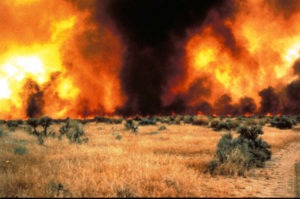
A fire in Mountain Home, Idaho in 2013 shows the black smoke of burning sagebrush and the lighter colored smoke of burning cheatgrass. The invasive cheatgrass will takeover areas where sagebrush dies out after fire making it difficult for the native species to grow back.
CREDIT MICHAEL PELLANT/BLM / U.S. FISH AND WILDLIFE HEADQUARTERS
University of Idaho Geography professor Crystal Kolden adds that fire isn’t the only obstacle for sagebrush. “Normally, if there is no cheatgrass the sagebrush would regenerate. But cheatgrass responds to fire by growing and covering more area that used to be sagebrush to the point where no sagebrush seedlings can get established. That is a key concern to loss of habitat to the sage grouse.”
The other obstacle Kolden says ecologist worry about is climate change. “We don’t know what species will be able to persist and grow back after a fire because of climate change.”
But she says there are things you can do to help. “I think the challenge for the average citizen is actually help preserve what is left. Forests and sagebrush grow back over very long periods, much longer than most people will be around to see, since it takes decades to centuries to regenerate. But people can support forest management efforts, like prescribed fire, that will help preserve the forests and sagebrush that are left. Preserving those remnants is crucial because they provide habitat, and they provide the seed that will be used to replant the burned areas.”
Related Stories:

Why affordable housing providers say they’re facing an ‘existential’ crisis
Affordable housing providers across the Northwest have been contending with rising insurance premiums — and, in some cases, getting kicked off their plans altogether.
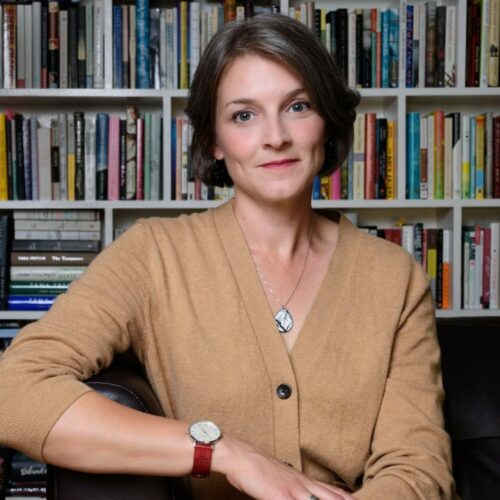
Pacific Northwest author’s new novel captures atmosphere of the region
On a gray, early spring morning, I drove to Steilacoom, Washington, to catch the ferry to Anderson Island. I boarded alongside the line of other cars and after parking, stepped out onto the deck of the boat. The ferry pushed off from the dock and rocked a little in the Puget Sound before steadying.
I took this journey to the real Anderson Island to see from the water what inspired Northwest author Kirsten Sundberg Lunstrum’s new novel, “Elita,” which was published earlier this year. Sundberg Lunstrum was inspired while sailing around the Puget Sound to write a mystery novel on an island.
Sundberg Lunstrum read excerpts of the book at a gathering at Tacoma’s Grit City Books.

Repentina suspensión de Head Start afecta a cientos de niños en el centro de Washington
Suspensión de los programas Early Head Start y Head Start afecta a siete Inspire Development Centers en el centro de Washington, dejando a más de 400 niños sin apoyo educativo después de que la financiación federal nunca llegara. También provocó el despido de más de 70 personas.












